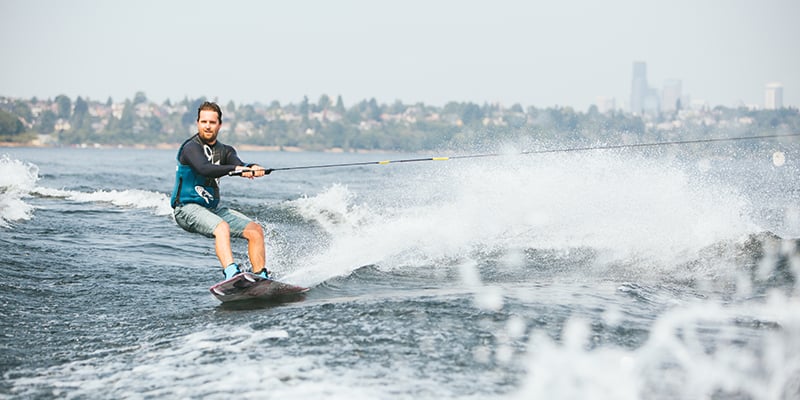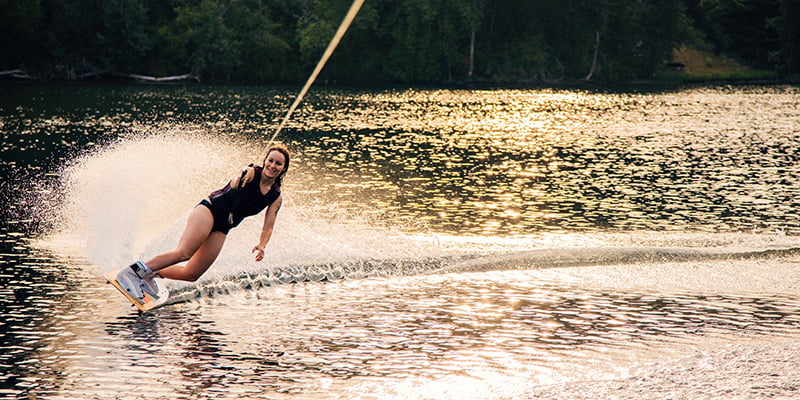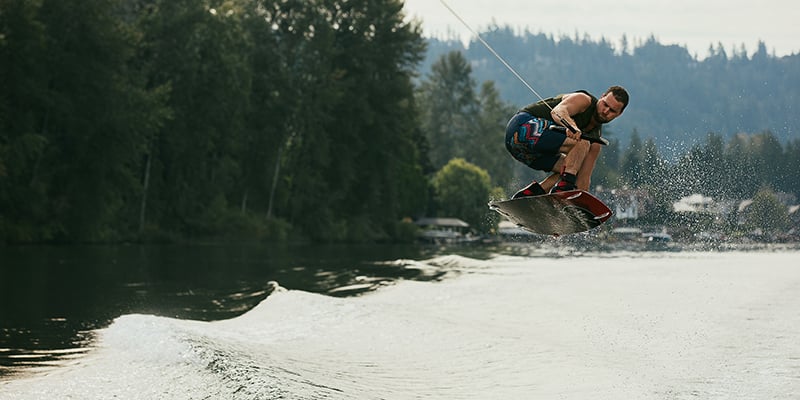How to Wakeboard - Beginner Wakeboarding Tips
Doing anything for the first time is intimidating, and wakeboarding is no exception, however, with a couple of pointers, you’ll be up and on the water in no time. Learning to wakeboard is incredibly fun and rewarding, plus, once you have the hang of the basics, you’ve unlocked a whole new world of possibilities on the water and the progression comes fast. So, without further ado, let’s hop into some wakeboarding basics, and help teach you how to wakeboard.
What You Need To Go Wakeboarding
What to Wear Wakeboarding?
Before you get out there on the water, it’s important to be prepared. What to wear is step number one. A swimsuit is obvious, but here are a couple of tips to remember. While you may want to go out there and show off that summer body, opting for some more coverage will help to keep you protected, and keep in mind you’ll be wearing a life jacket, so choose a swimsuit that’s supportive and comfortable under a lifejacket. Beginner wakeboarders might want to consider wearing a wetsuit or rashguard, too. As a beginner, you’ll likely spend more time in the water, which can get chilly depending on where you are. More coverage also protects you better from any falls you might take.
Likely the most important item you’ll wear wakeboarding is a life jacket. Not only do life jackets keep you afloat, but they’ll also offer some protection when you fall. Make sure to choose a properly fitting Coast Guard Approved life jacket that is rated for your size and weight.
Choosing the Best Beginner Wakeboard
Your wakeboard and bindings are the next pieces of the puzzle. What do you want to look for when choosing a beginner wakeboard setup? A few things, namely stability, comfort, and durability. For a full breakdown, read our guide to choosing a wakeboard, and our guide to choosing wakeboard bindings.
Wakeboards for beginner riders seek to offer the best stability and predictability, giving you a nice platform to learn on. There are a couple of important design specs and features that help achieve this, namely length, rocker, and shape. Beginners should typically lean towards a longer board - as the extra length will help with stability. Rocker is another important consideration. A smooth continuous rocker design is found on the best beginner wakeboards because it gives a more predictable feel on the water, where wakeboards for more advanced riders will often feature a 3-stage rocker for more pop off the wake into the air. Finally, the shape of the board. Beginner wakeboards are shaped for stability rather than all-out speed and air, some even feature designs that make the board easier to turn, especially on the toeside.
How to Get up on a Wakeboard?
- Tie the rope up as short as you can.
- Make sure your board is set up properly.
- Get lined up with the boat.
- Let your knees bend as much as they can as the boat begins to move.
- Hold this crunched position until you’re over top of your board.
- Stand up slowly.
The first step to getting up on a wakeboard is to set your self up for success. This means tying up the wakeboard rope as short as you can. This will increase the amount of upward pull from the boat, helping you stand up. The nest part of the set up is your board. Make sure your feet are about shoulder-width apart, with your feet slightly turned out. This will give you the most amount of stability. Stand facing outwards towards the back of the boat, this way you can just sit on the swim step and scootch your way into the water. If you jump into the water, you can fall back into the boat, starting your wakeboard experience with a painful crash. Now that you’re in the water it’s time to get up on that wakeboard.
Getting up on a wakeboard is all about letting the boat do the work. To start, get lined up with the boat, with your arms straight, resting on your knees. Your knees should be slightly bent. When the boat starts to go, let your knees bend as much as you can, with your butt crunched down towards the board. Hold this crunched position all the way until you feel like you’re completely over the top of your board. Once you’re over the top of your board, you can stand up. Stand up slowly - rushing it is one of the most common mistakes beginner wakeboarders make. Now that your up, you can gently rotate your dominant foot to the back, away from the boat, now you’re wakeboarding!

Another common beginner wakeboarding mistake is fighting it, and trying too hard. Let the boat and the water work for you. Being relaxed and patient will not only help you get up more easily, but you’ll also be less tired as your working with, not against the forces. This means don’t pull with your arms, or push with your legs when trying to stand up.
If you feel like your arms are being pulled forward, towards your board, this is a sign that you are not bending your knees enough. More knee bend will keep you centered, and allow the boat to pull you up.
Once you get up, you have a couple of options. First, you can put some gentle pressure into your heels. This will pull you out to the outside of the wake. Or, you can stay directly behind the boat, with the rope at your hip, and the weight evenly distributed across your feet.

How to Turn on a Wakeboard?
The most common terms to describe turning on a wakeboard are toeside, and heelside, just like snowboarding. On a heelside turn, you put pressure into your heels, digging the back edge of the board into the water. Toeside turns, intuitively, are where you pressure your toes, digging the front edge of the board into the water. Getting a feel for these turns lays the foundation for riding the wake.
Toeside turns are more difficult for most riders. To turn toeside, you have to stand up all the way straight, and lean into the rope. Arcing your back can help to increase leverage, and get even more pull on the line. If you find yourself getting stuck, it’s probably because you’re trying to lean the way you’re trying to turn, rather than leaning back into the rope. “If you break at the waist, you’ll fall on your face!” So lean back into the rope hard, and you’ll be ripping in no time.
Beginner Wakeboarding Tricks
Once you have the fundamentals down, learning both strong heelside and toeside turns, you can really unlock your wakeboarding progression with some beginner wakeboarding tricks. The first tricks to learn on a wakeboard are toeside one-way jumps, heelside one-way jumps, and surface 180s & switch riding. When you have these basics on lock, you can start trying some spins on your wakeboard. Start by going for frontside 180s, both heelside and toeside. From there, the sky is the limit!

How to Drive a Wakeboard Boat?
As the driver of a wakeboard boat, you can help the rider’s success in a few different ways. One of the first things to think about is communication. Turn the music down, and develop an effective way to communicate before anyone gets in the water, there’s nothing worse than being on a different page than your driver.
To pull a wakeboarder, start slow. You do not need to yank the rider up, like in waterskiing, easing up to speed will help them get up easily and safely. Tow speeds for wakeboarding vary, and can be anywhere between 15 to 25mph. Once the rider is up, it's all about being smooth and consistent. For more information, check out our guide to wakeboarding boat setup and tow speeds.
Learn More With Our Other Wake Guides:
Wakeboard Size Chart & How to Choose
Wakeboard Boots & Bindings - How to Choose
Wakeboard & Binding Compatibility Guide
Wakeboard Tow Speed, Rope Length & Boat Weight
Wakeboard Life Jacket & Vest Size Guide
Wakeboard Ropes & Handles - How to Choose
How to Wakeboard: Beginner Tips & Getting Started
